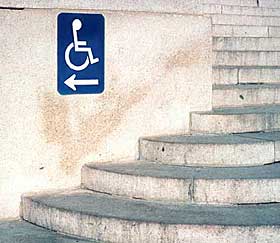When a town becomes aware that a program is not accessible and plans to alter a facility to provide access, it may be necessary to temporarily relocate a program, service, or activity to a temporary accessible location or to temporarily offer the service in an alternate manner.
This temporary solution assures that the service, program, or activity is accessible during the time the alterations are planned and being implemented.
Example
The public toilet facilities at the town recreation area are not accessible. After consideration of whether to modify the facilities or to relocate the programs held at the recreation area, the town decides to alter the toilet facilities and the walkway leading to them. While the fundraising is done, alterations planned, and the work completed, the town provides temporary portable toilet facilities that are accessible.
When choosing a method of providing program access, a public entity must give priority to the one that results in the most integrated setting appropriate to encourage interaction among all users, including individuals with disabilities. In addition, a town may offer additional activities or services so an individual with a disability can more fully participate in, or benefit from, a program, service, or activity. However, when such special activities or services are provided for people with disabilities, the town must permit a person with a disability to choose to participate in services, programs, or activities that are not different or separate.
Example
The local town pool provides a swimming program for people with disabilities that includes additional staff who provide individualized instruction. A person with a disability participates in the program. The person applies to attend group swimming lessons that are open to the public even though these lessons do not provide specialized instruction. The town must permit the individual with a disability to participate unless doing so would fundamentally alter the program
Because program accessibility may be provided in an accessible part of a facility when the remainder of the facility is not accessible, the public must be informed of the location of accessible features. Signs should direct the public to the location of accessible elements and spaces, including the location of accessible parking, the accessible entrance to a facility, and accessible toilet rooms. In addition, a town may issue a brochure or pamphlet with a map indicating the town's accessible features.
Example
A town hall has two sets of public toilet rooms. One set has been altered and is accessible, and the other set is not accessible. The town installs signage at the inaccessible toilet rooms directing people to the accessible toilet rooms.

Sign at an inaccessible entrance provides directions to the nearest accessible entrance
Towns making modifications to a building or facility to provide program accessibility must comply with the ADA Standards for Accessible Design (ADA Standards) or the Uniform Federal Accessibility Standards (UFAS).

User Comments/Questions
Add Comment/Question